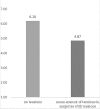"Disruptive behavior" in the operating room: A prospective observational study of triggers and effects of tense communication episodes in surgical teams
- PMID: 31830122
- PMCID: PMC6907803
- DOI: 10.1371/journal.pone.0226437
"Disruptive behavior" in the operating room: A prospective observational study of triggers and effects of tense communication episodes in surgical teams
Abstract
Background: Tense communication and disruptive behaviors during surgery have often been attributed to surgeons' personality or hierarchies, while situational triggers for tense communication were neglected. Goals of this study were to assess situational triggers of tense communication in the operating room and to assess its impact on collaboration quality within the surgical team.
Methods and findings: The prospective observational study was performed in two university hospitals in Europe. Trained external observers assessed communication in 137 elective abdominal operations led by 30 different main surgeons. Objective observations were related to perceived collaboration quality by all members of the surgical team. A total of 340 tense communication episodes were observed (= 0.57 per hour); mean tensions in surgeries with tensions was 1.21 per hour. Individual surgeons accounted for 24% of the variation in tensions, while situational aspects accounted for 76% of variation. A total of 72% of tensions were triggered by coordination problems; 21.2% by task-related problems and 9.1% by other issues. More tensions were related to lower perceived teamwork quality for all team members except main surgeons. Coordination-triggered tensions significantly lowered teamwork quality for second surgeons, scrub technicians and circulators.
Conclusions: Although individual surgeons differ in their tense communication, situational aspects during the operation had a much more important influence on the occurrence of tensions, mostly triggered by coordination problems. Because tensions negatively impact team collaboration, surgical teams may profit from improving collaboration, for instance through training, or through reflexivity.
Conflict of interest statement
The authors have declared that no competing interests exist.
Figures




